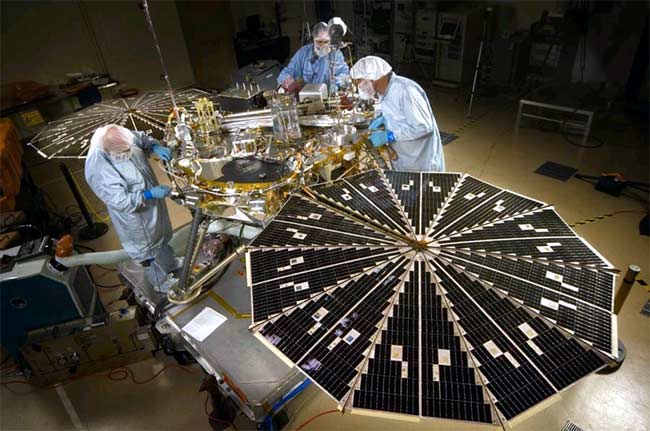Phoenix Lander Readied For Mars Exploration

GOLDEN, Colorado - NASA's next mission to Mars--the Phoenix lander--is undergoingreadiness testing in preparation for an early August launch window.
Forthe first time since NASA's Viking missions in the 1970's, the plan calls forPhoenix to safely settle down on Mars using a set of onboard rocket thrusters--noairbags this time as successfully used by NASA's last three red planetlandings.
When Phoenix touches down within the northern polar plains of Mars, it will beready for research duties. This stationary probe is armed with a robotic scoopto dig and scratch into the martian surface for answers regarding the historyof water on Mars and the planet's potential as an extraterrestrial address forlife.
Thespacecraft is the first in the space agency's low-cost, Scout-class of a spacemission. Phoenix did experience technical challenges, particularly in thecraft's radar system, causing a cost overrun from an earlier cost-cap figure of$386 million.
Phoenix project officialsdiscussed the spacecraft's status and future voyage today at a press briefingheld at Lockheed Martin Space Systems near Denver, the site where the Mars landerwas built and being readied for flight.
Green Valley
Stillbeing discussed is exactly where to touch down in order to avoid dangerousgeography, said Peter Smith, Phoenix principal investigator at the University of Arizona in Tucson.
Get the Space.com Newsletter
Breaking space news, the latest updates on rocket launches, skywatching events and more!
Smithsaid that scientists thought they had selected a safe Phoenix landing spot.However, new imagery of that selected area taken by a super-powerful camerasystem onboard NASA's Mars Reconnaissance Orbiter found it littered withenormous boulders. "It was not a very safe place to land," he said.
Usingboth the MRO and NASA's Mars Odyssey orbiter, three sites are now beingintensely mapped, to assure that Phoenix has a high probability of touchingdown safely.
Inplotting out landing areas, "we paint the parts green that we think are thesafest places...and we have a place we call 'Green Valley' now that's so greenthat it looks very secure for us," Smith told reporters today.
Pickingthe actual piece of martian real estate that Phoenix will plop down on isexpected in early March, Smith said. "We want to select both a safe site and ascientifically interesting site...with safety being number one of course...or elsewe don't get anything."
Seven minutes of terror
Getting Phoenix down through the red planet's atmosphere onto the landscape of Mars isthe most harrowing part of the mission, said Barry Goldstein, Phoenix projectmanager at NASA's Jet Propulsion Laboratory (JPL) in Pasadena, California.
"Weget seven minutes of terror," Goldstein explained. Trying to deliver a vehiclelike this from a high speed and heated plunge of 12,600 miles per hour to zeroand a100 million miles away "is no easy shot," he added.
Goldsteinsaid that in March of last year, the Phoenix project started having "somesignificant challenges" in bringing the mission in at a $386 million cost cap.The team notified NASA Headquarters of the overrun last August, requesting anew slug of money, he added, roughly $31 million.
Ata meeting last week, Goldstein said that NASA officials gave the project ago-ahead, although the final price tag of the mission has yet to be fullyvetted. "The vehicle is behaving very nicely. Things are looking goodtechnically as well as with the schedule and where we are headed. We have nothreats to launch at this point," he said.
Exercise in optimization
Phoenix is to be shippedto Florida in early May and undergo final pre-launch checkout, said EdwardSedivy, Phoenix program manager at Lockheed Martin Space Systems. The lander is"very strong and very robust from the test perspective," he noted.
ABoeing Delta 2 booster is to hurl Phoenix toward Mars.
Thethree-legged, solar-powered Phoenix carries a flat deck outfitted with scienceinstruments, a camera-tipped mast, as well as a highly flexible robot arm."It's really quite a packaging challenge," Sedivy said. "This is really anexercise in optimization."
Once Phoenix is operating on Mars, after softly setting itself down on the redplanet in late May 2008, the objective of the mission is to use its sterilizedarm, scoop and grinder to gather ice samples for on-the-spot study.
"Wewill try and analyze the properties of the ice and its relationship to the soiland the atmosphere," Smith pointed out. "It's the water that we expect to findthere...and be the first mission to actually reach down and get a handful of icysoil and analyze it."
Thesearch for evidence of a habitable zone and assess the biologic potential ofthe ice-soil boundary is high on the scientific agenda for Phoenix.
Scientistswill interpret this data and try to understand "what the truth of Mars reallyis in this area," Smith observed. At the end of the Phoenix lander mission, researchershope to witness the planet's onslaught of polar ice that will permeate thespacecraft's exploration area.
"Atour landing site there will be as much as three feet of solid carbon dioxideice...we don't expect to survive through the winter," Smith concluded.
- Images: Visualizations of Mars
- Phoenix Mars Lander: Getting Down and Dirty On the Red Planet
- Phoenix Mars Lander: Strong Arming The Red Planet
- All About Mars
Join our Space Forums to keep talking space on the latest missions, night sky and more! And if you have a news tip, correction or comment, let us know at: community@space.com.

Leonard David is an award-winning space journalist who has been reporting on space activities for more than 50 years. Currently writing as Space.com's Space Insider Columnist among his other projects, Leonard has authored numerous books on space exploration, Mars missions and more, with his latest being "Moon Rush: The New Space Race" published in 2019 by National Geographic. He also wrote "Mars: Our Future on the Red Planet" released in 2016 by National Geographic. Leonard has served as a correspondent for SpaceNews, Scientific American and Aerospace America for the AIAA. He has received many awards, including the first Ordway Award for Sustained Excellence in Spaceflight History in 2015 at the AAS Wernher von Braun Memorial Symposium. You can find out Leonard's latest project at his website and on Twitter.









